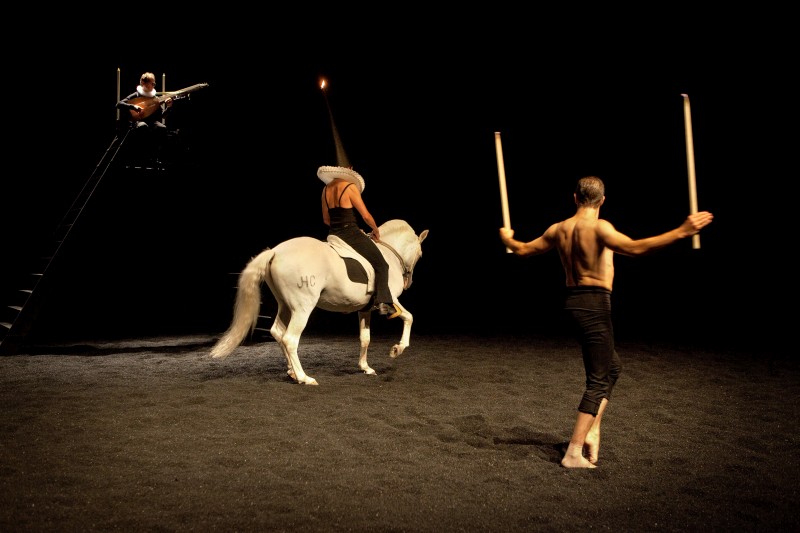 This is my second meeting with the equestrian theatre of Bartabas and once again I find it a complex and challenging task to write about it, not least because Bartabas’s theatre-based work lies in a rather distinct category of his own.
This is my second meeting with the equestrian theatre of Bartabas and once again I find it a complex and challenging task to write about it, not least because Bartabas’s theatre-based work lies in a rather distinct category of his own.
Although Bartabas’s performances are built on the foundations of his deep partnership with horses, his theatre-performances are not what you could safely call circus. And although he often collaborates with dancers (and this work contains a good deal of flamenco), I hesitate to call this a dance. Perhaps then it is necessary to latch onto the fact that Golgota (called after the alternative name for Calvary) draws on the paintings of El Greco and the Spanish artist Francisco de Zurbarán, and to note that it has echoes of the work of Romeo Castelluci. Therefore it might be more accurate to call Golgota a series of ritualistic vignettes, or a series of moving paintings. Like the Stations of the Cross in Catholic churches, Golgota presents a series of images that draw on the journey of the Christ-figure towards his crucifixion.
Accompanying this journey is the music of another Spaniard, the 16th century composer Tomás Luis de Victoria. This takes the form of sparse, sacred music for various permutations of lute, counter-tenor, and cornet. These transcendent melodies serve to still time – to allow us to ‘sit’ into the images that Bartabas presents – as if held in suspension as the stage pictures slowly morph.
It is important to note that Bartabas’s theatre-based work always originates in his desire to collaborate with a specific artist. In this case it is his collaboration with the flamenco dancer and choreographer Andrés Marín. This is a particularly intriguing choice, not only because the stage floor is covered with rubber-chips and thus Marín is often denied flamenco’s characteristic driving rhythm of the feet, but more importantly because Marín’s explosive and dynamic dancing lies in direct counterpoint to the apparent contained and gentle movements that Bartabas finds with his horses. And it is with these horses that Marín must find an accord.
As with the presence of any animal on stage the hardest task for a human performer is to equal the animal’s degree of presence. In Golgota the solution has been to craft a world of magic and mystery, and for Marín to star as the grandmaster of these human rituals. Stripped to the waist his dancing conjures moments of religious excitation, of numinous transcendence: his limbs arc out into space, he strikes bold contrapposto poses, and leaps and spins with whip-like speed.
The dominant colour in Bartabas’s palette is black, or rather that hazy darkness that comes about when a theatre space is lit with simple and limited shafts of light. Through this chiaroscuro ride Bartabas and his horses, their slow and rhythmical gaits counterpointing Marín’s explosive speed.
The horses are stately, serene. If Marín is a kind of flagellant – his physical struggle taking him away from the earthly plane – then the horses are the embodiment of his detachment from the physical. Apparently ethereal but clearly tangible, they gently canter in wide circles, spin on the spot, or high-step their way around the space. Atop sits Bartabas – almost immobile, except for shifts of weight or the gentle sway of his legs. He is almost incidental in some moments (his face masked), and at others he strikes simple sculptural poses with his arms outstretched.
Drawing on the ceremonial processions of Seville’s Holy Week, these figures take on and put off items of clothing – a huge black conical hat and a bone-white ruff for example – transforming them into penitent-priests. Beguilingly, these priests move towards the conclusion, when Marín – having donned a pair of ‘shoes’ that transform his feet to equine hooves – struggles to ascend the ladder to take his place on the cross. Here he hangs – feet striking the cross’s base – an anti-rhythmic dance of his final surrender to the transcendent plane of the animal.
And this is how Bartabas’s work is best viewed – as an act of surrender to the transfixing delicacy of his equine partners. It is in their presence that it is possible to see the prize of faith – of leaving behind the pull of material plane. It is in their presence that it is also possible to see the folly of faith – that always the most transcendent act is the meeting with another living creature.

